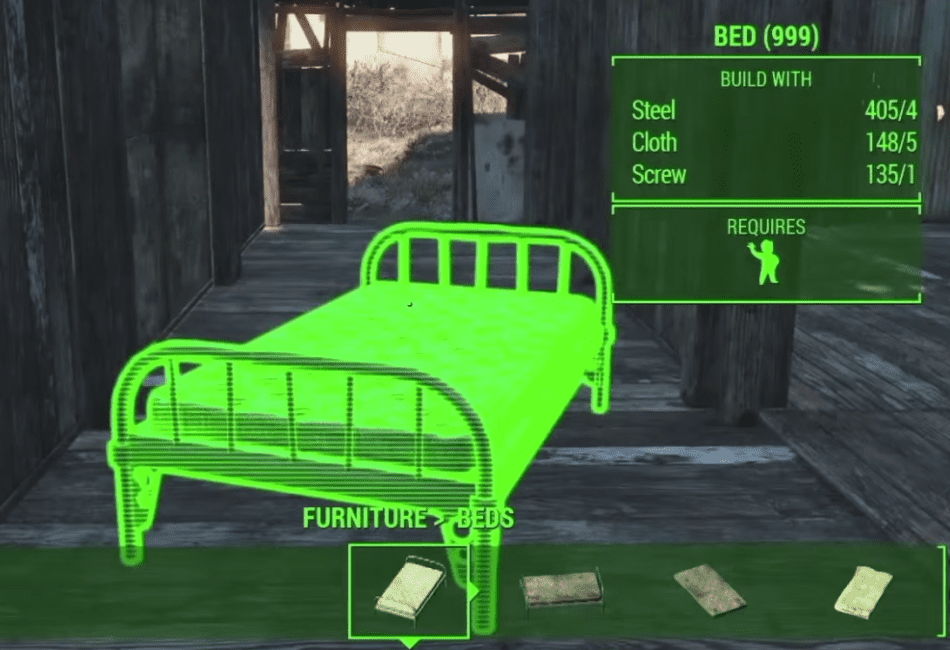- Fallout Shelter Best Weapons Guide - March 29, 2023
- Fallout Shelter Legendary Dwellers Guide - March 21, 2023
- Diamond City Guide - January 31, 2023
Intro
4 is the second go-around at a for and they made significant changes to the formula of games where war never changes. One of those changes is the crafting system.
In Fallout 3, there were a handful of custom weapon blueprints you could find, but that’s about it. You couldn’t modify those custom weapons in any way either. Fallout 4 changed all that by introducing an incredibly expansive crafting system that allows you to craft and personalize your weapons and much more.
There’s a lot to take in at first, such as all the materials and components used in crafting, crafting recipes, and game perks you’ll need. But don’t worry, as I’ve got you covered. Here is our Fallout 4 crafting guide with everything you need to know about Crafting in Fallout 4.
What is Crafting?
Crafting is the creation and or modification of objects and items in the world of Fallout 4. Making full use of the crafting system requires crafting components, certain perks, and the proper crafting tables.
Crafting Tables
There are six crafting tables available in the base game. Those are:
- Workshop
- Power Armor Station
- Armor Workbench
- Weapons Workbench
- Chemistry Station
- Cooking Station
DLC and add-ons are required if you want full access to everything available at crafting tables.
Workshop
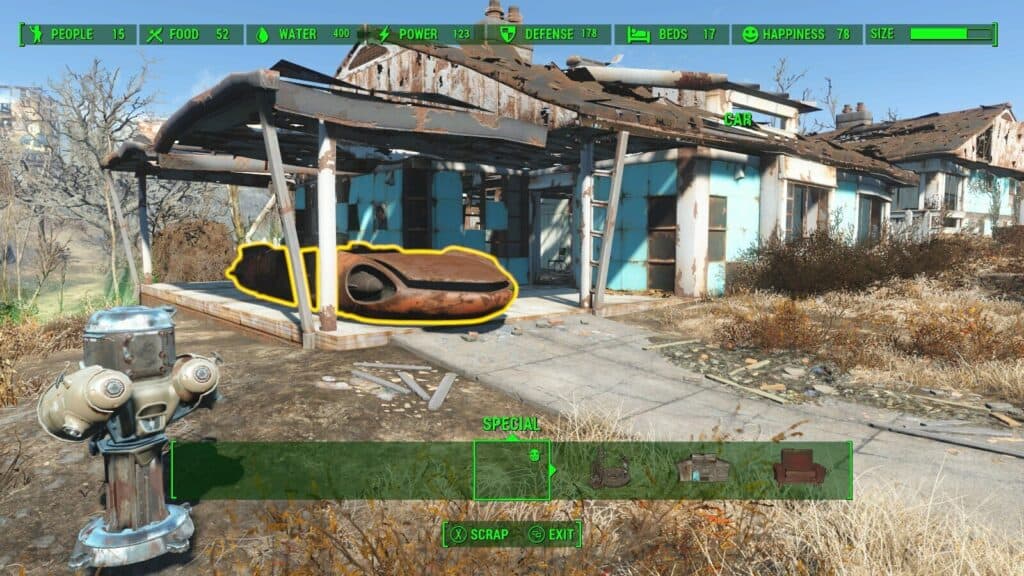
You can access the workshop anywhere within your settlement.
You use the workshop to scrap items in your settlement, store items, assign settlers jobs, and create settlement objects. While in workshop mode, yellow-highlighted items signify items you can only scrap. Green-highlighted items can be stored or moved around.
Power Armor Station
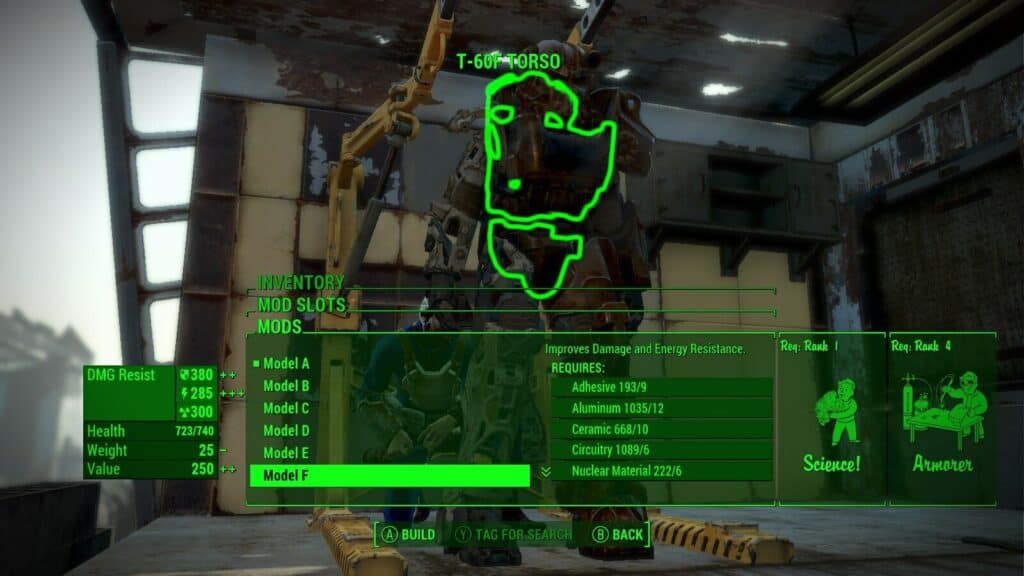
You can modify and repair any sets of Power Armor you have at a Power Armor Station.
You can also use this Power Armor Frame to give your Power Armor new paint jobs. Everyone starts with a default selection of paint jobs, but several additional ones exist. To access them, you need to find issues of Hot Rodder in the Commonwealth.
Armor Workbench
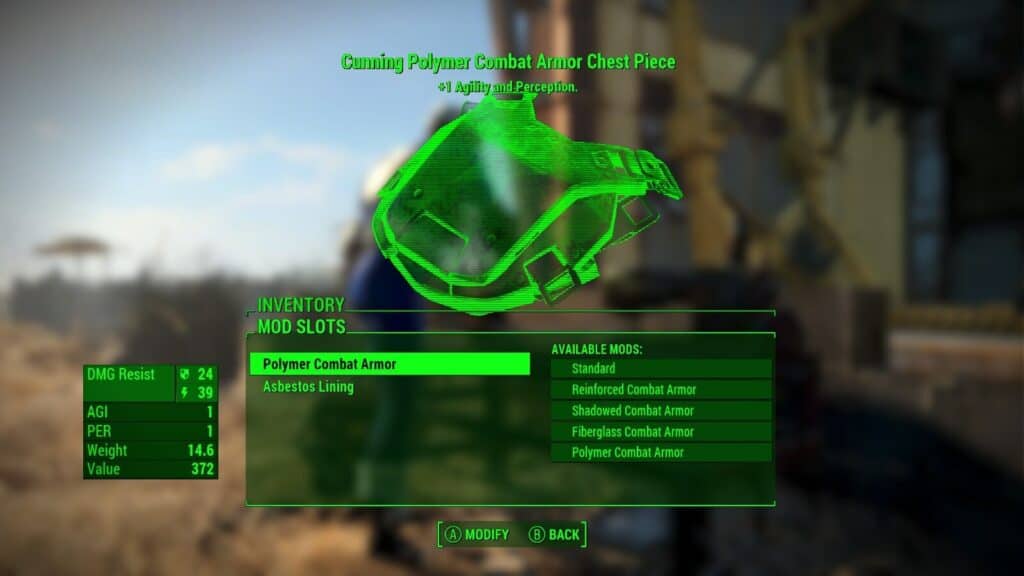
You use the armor workbench to scrap and modify armor pieces and certain clothing items.
You can only mod armor pieces. Armor sets like Helmeted cage armor cannot be modded. Similarly, not all clothing/hats can be modded and you can not here, so take your or your elsewhere. To get the most out of clothing in Fallout 4, you need to help the Railroad so you can learn how to use the ballistic weave mod.
Weapons Workbench
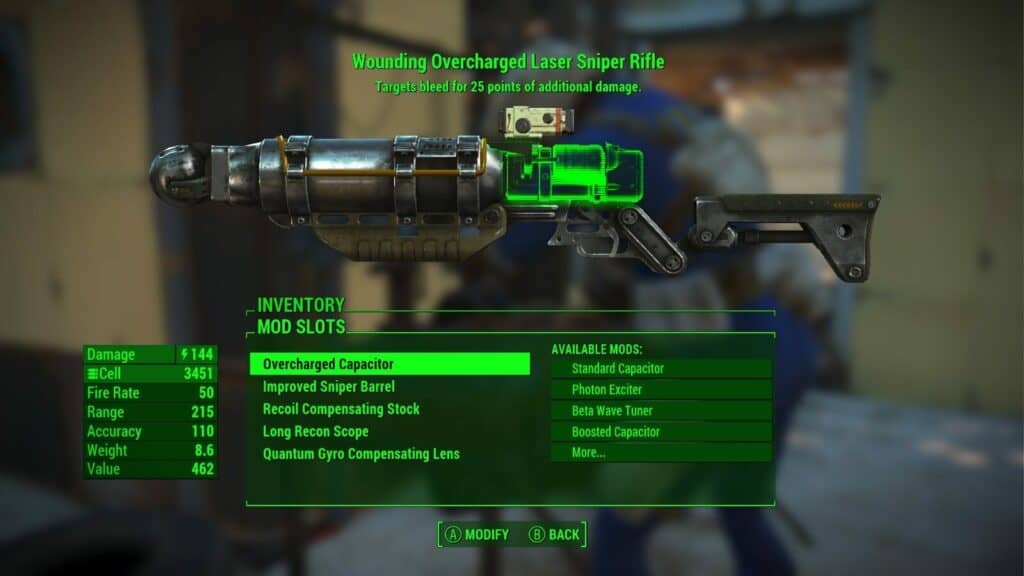
You use the weapons workbench to scrap and modify weapons like firearms and melee weapons.
You can mod pretty much every weapon in the game, though not all weapons are equally mod-friendly. Melee weapons, for example, often only have one possible mod. Big guns like miniguns and missile launchers also possess fewer fallout mods compared to weapons like rifles or pistols.
Chemistry Station
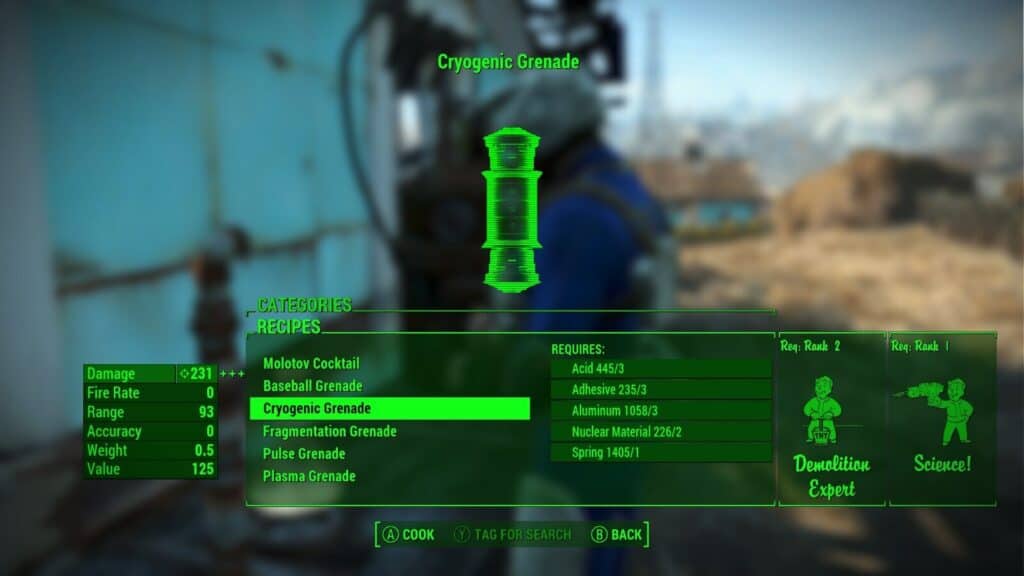
You use the chemistry station to craft chems, medicine, grenades, mines, traps, fireworks, and cutting fluid (More on this later).
Cooking Station
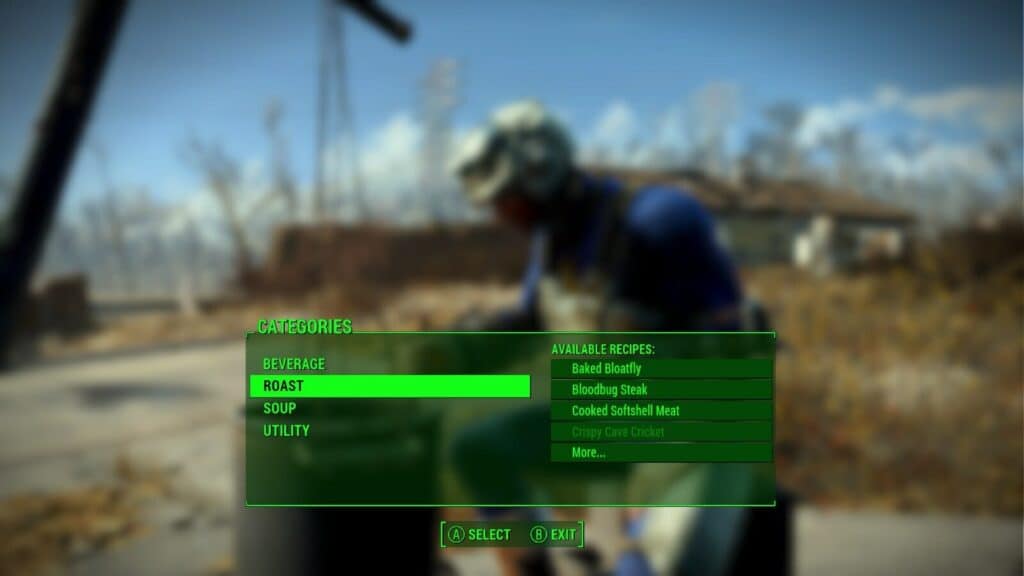
You use the cooking station to create new food dishes with edible items you find out in the Wasteland. You can create everything from steak and omelets to soup and stew. The meals you craft at cooking stations have more potent healing effects than the raw items used to create them. Additionally, cooking food eliminates the radiation damage you would ordinarily take when consuming raw food items.
You can also use the cooking station to create beverages and vegetable starch (Definitely more on this later).
DLC/Add-On Crafting Tables
There are 12 additional crafting tables, but you need the Automatrons DLC, Nuka-World DLC, and Contraptions Add-On to access them. Additionally, the add-ons Far Harbor, Wasteland Workshop, and Vault-Tec Workshop don’t introduce new crafting tables, but they introduce new items and objects you can create. Those crafting tables are:
- Robot workbench
- Ammunition plant
- Armor forge
- Auto-loom
- Builder
- Energy weapon forge
- Explosives mill
- Food processor
- Heavy weapon forge
- Pyrotechnics forge
- Weapon forge
- Nuka-mixer stations
Robot workbench
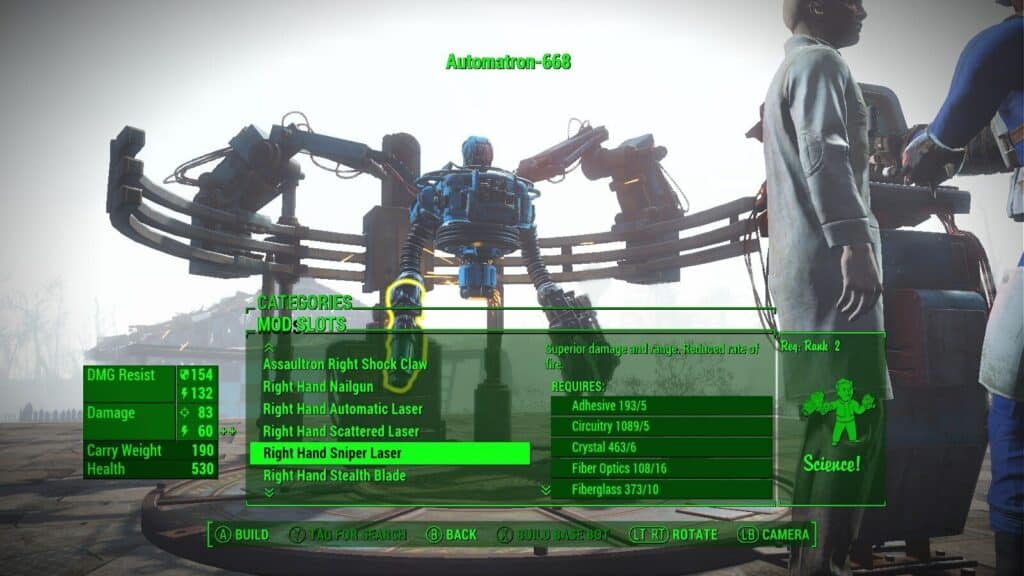
Requiring level 15 to start, the Automatron DLC introduces the robot workbench into the game.
You can modify pre-existing robot companions Codsworth, Curie, and Ada via the robot workbench. You can also create custom robots which you can then use as settlers and followers.
You must complete the first quest of the Automatron DLC to use a robot workbench.
Ammunition plant
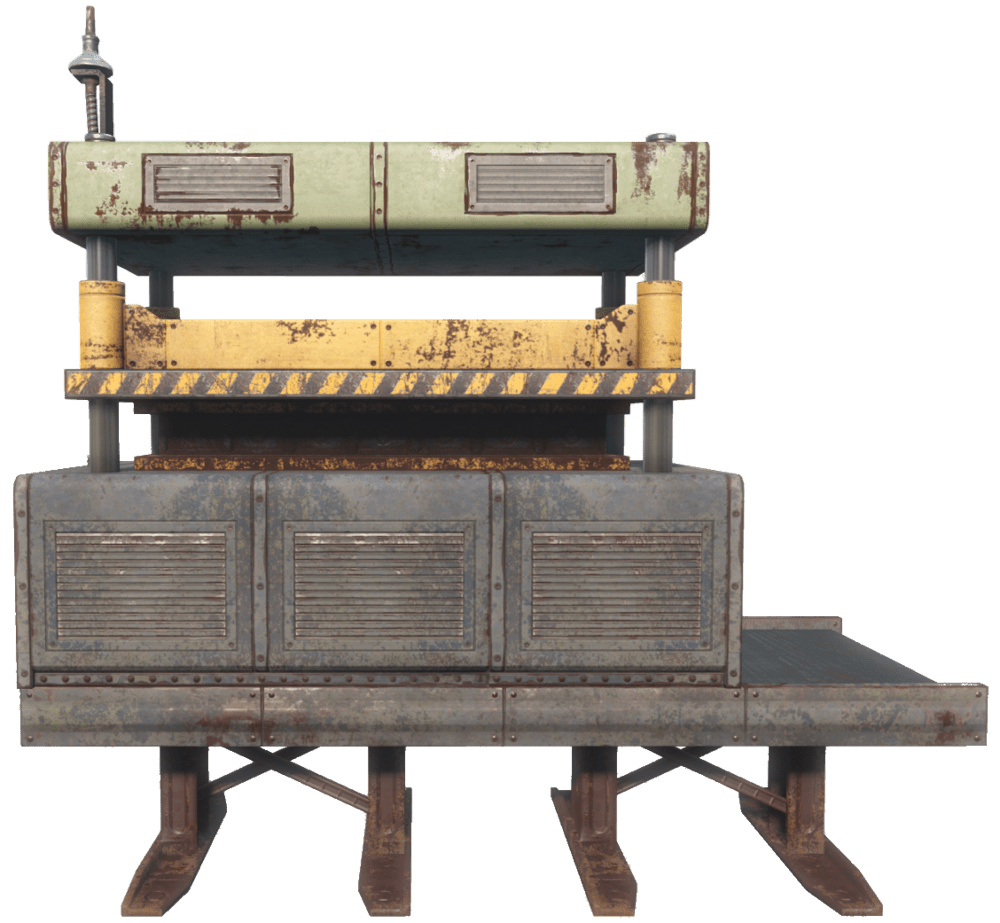
Added with the Contraptions add-on, the ammunition plant allows you to create various ammo types using raw materials. You cannot craft ammo types from Far Harbor or Nuka World.
Armor Forge
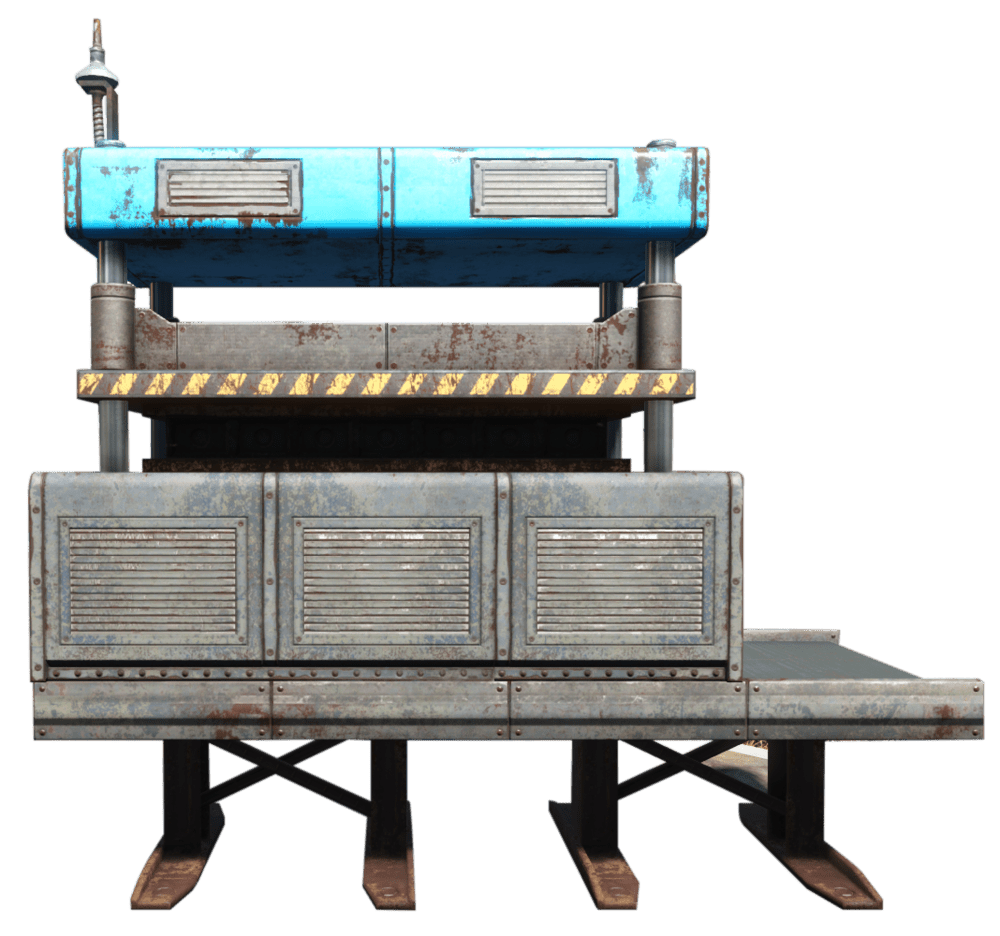
The armor forge allows you to craft all three tiers of leather, metal, and combat armor from raw components. However, the armor piece crafted will be random, so you might not get what you want on the first attempt.
Auto-loom
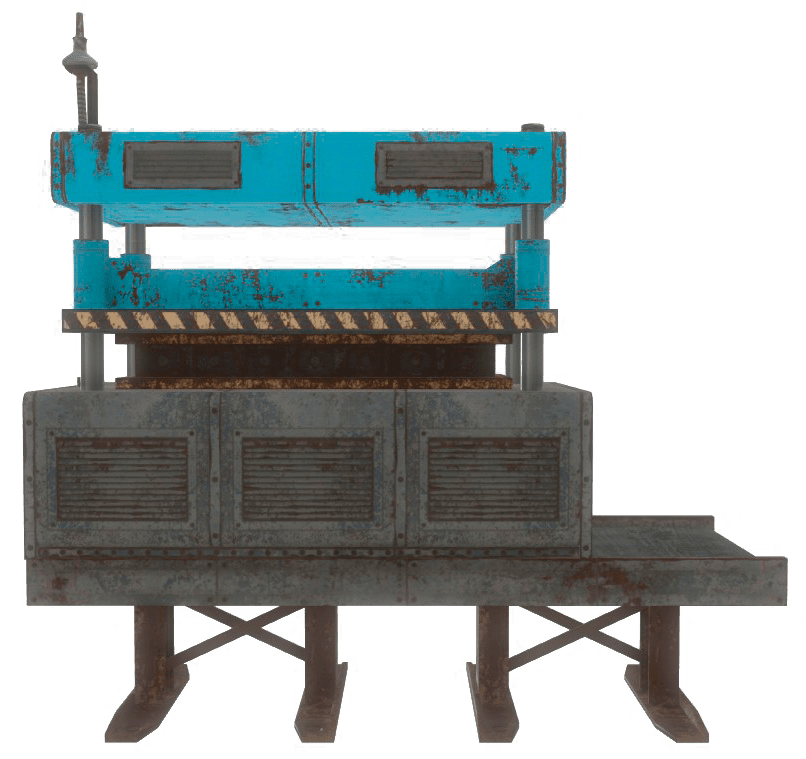
The auto-loom can craft 1 of 16 clothing outfits for three cloth and one adhesive.
Builder
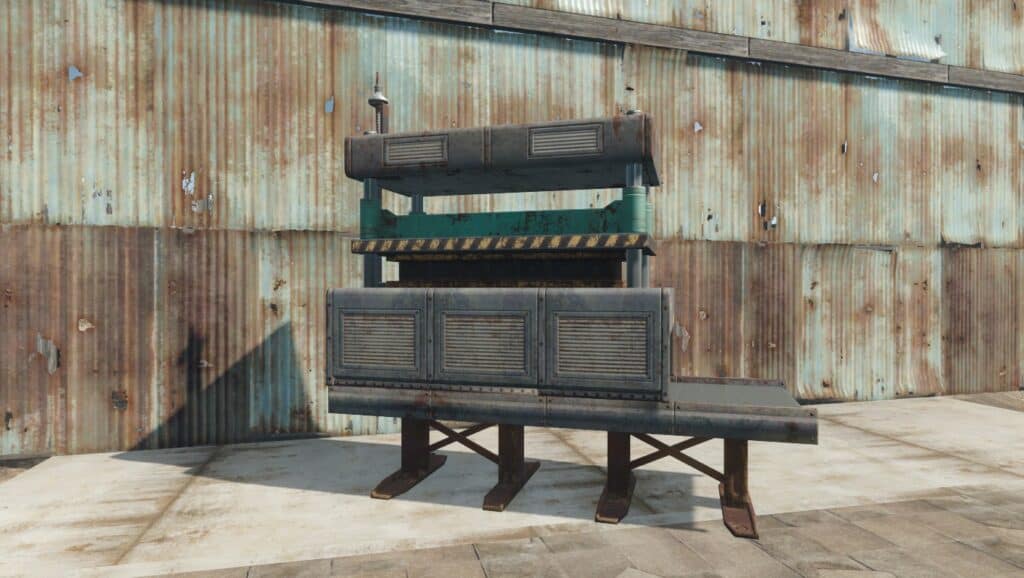
The Builder can create 1 of 11 junk items by inputting the required crafting components.
Energy weapon forge
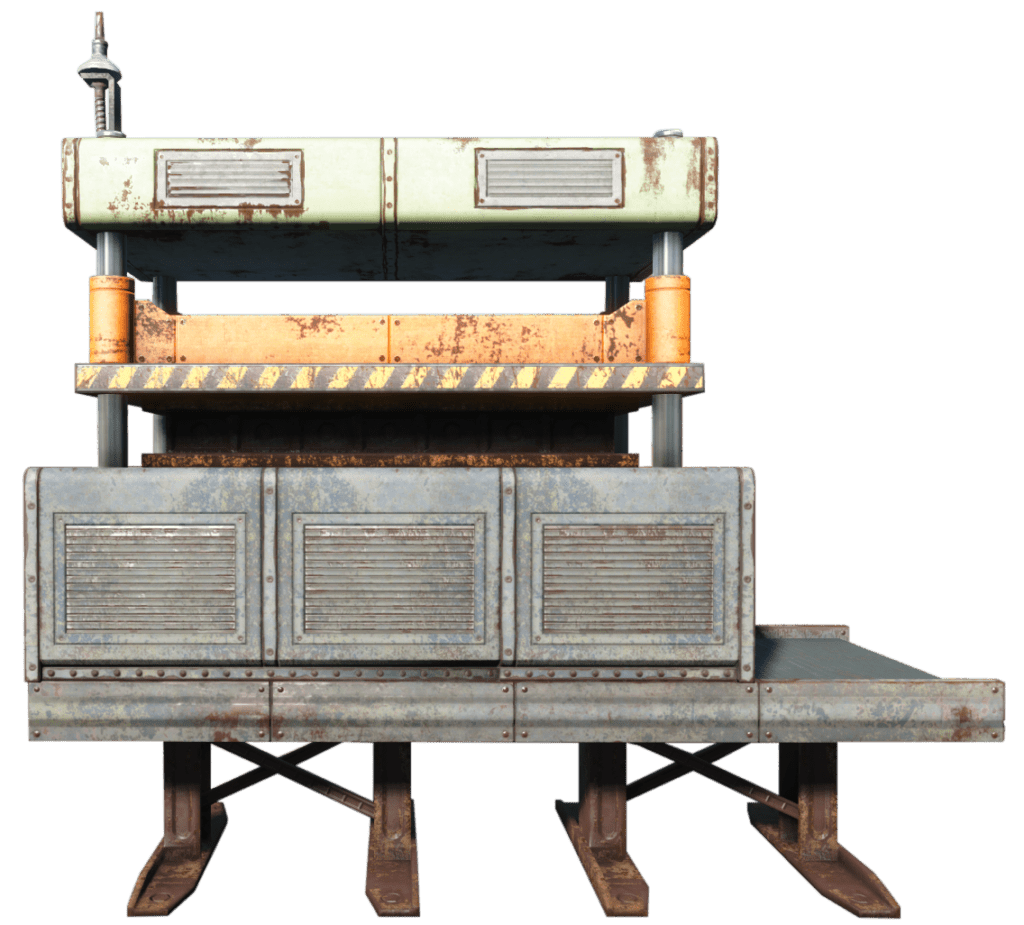
The energy weapon forge can craft five different energy weapons by inputting specific crafting components into the machine. You cannot craft Institute energy weapons.
Explosives mill
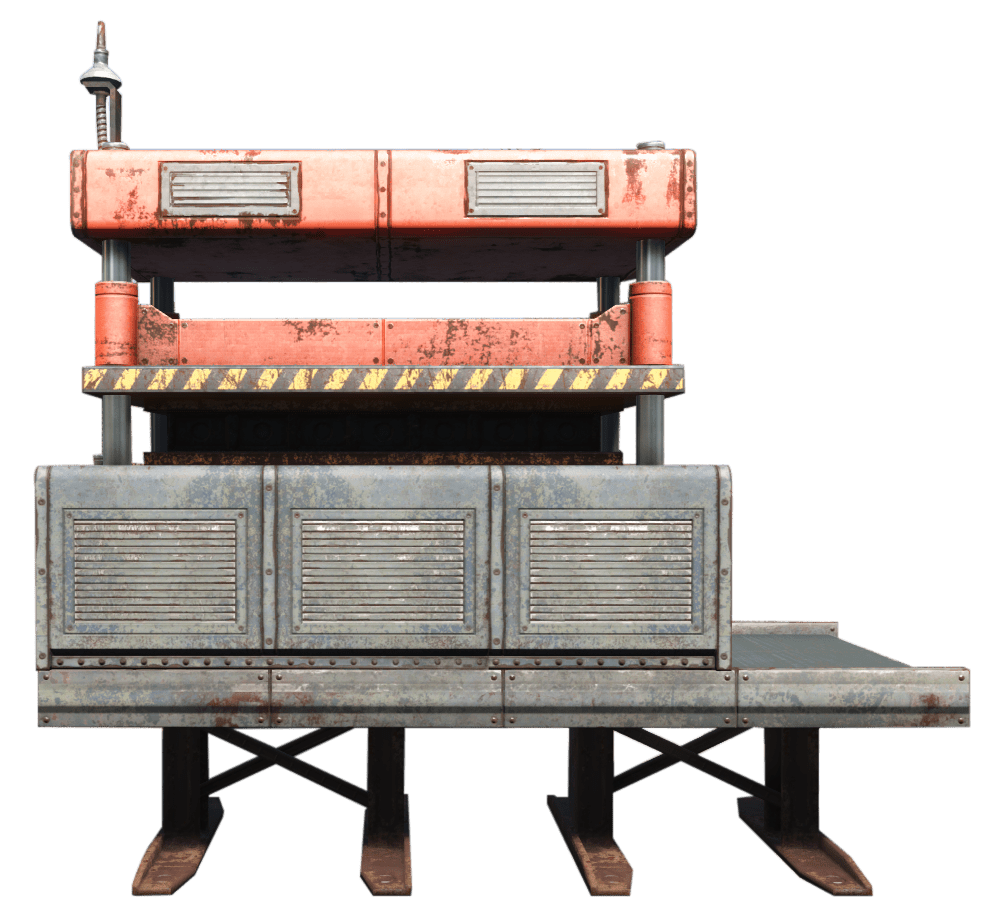
The explosives mill can craft 1 of 11 different explosive weapons by inputting specific crafting components into the mill.
Food processor
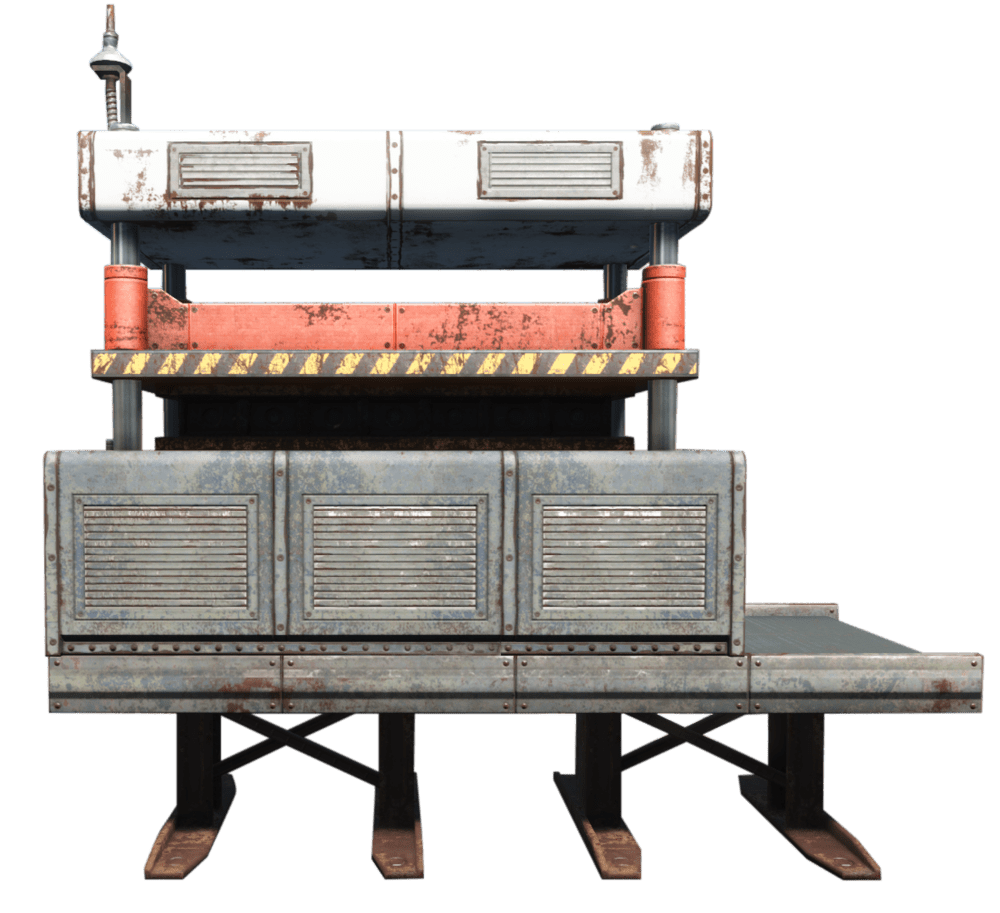
The food processor creates pre-War quality food like Cram and Potato Crisps by inputting specific crafting components and consumable food items into the processor.
Heavy weapon forge
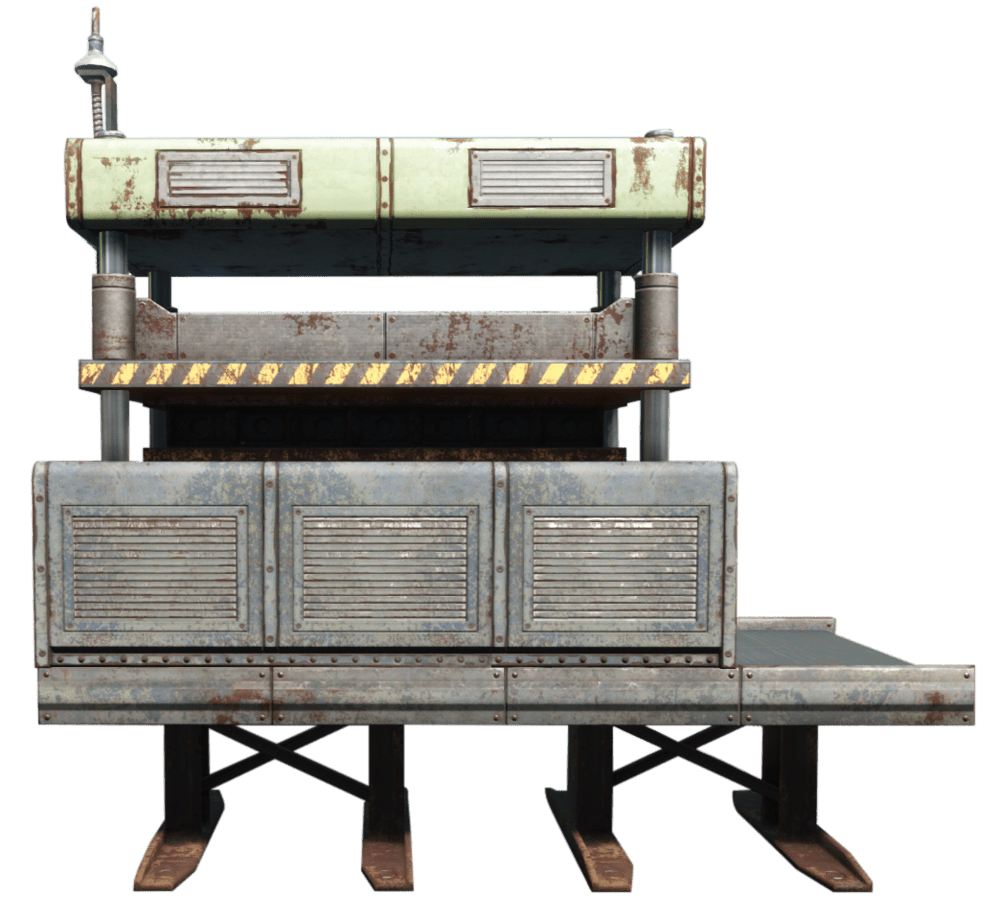
The heavy weapon forge uses crafting components to create four different heavy weapons.
Pyrotechnics mill
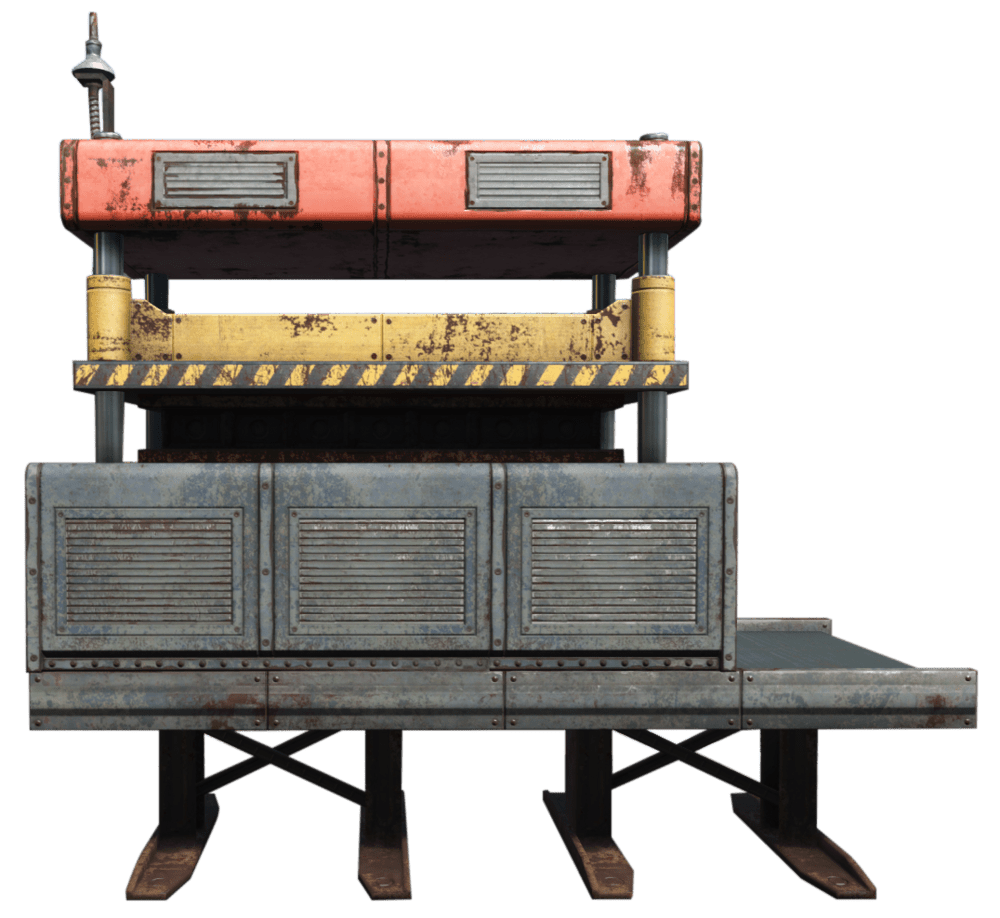
The pyrotechnics mill uses crafting components to create numerous firework shells and weather change shells.
Weapon forge
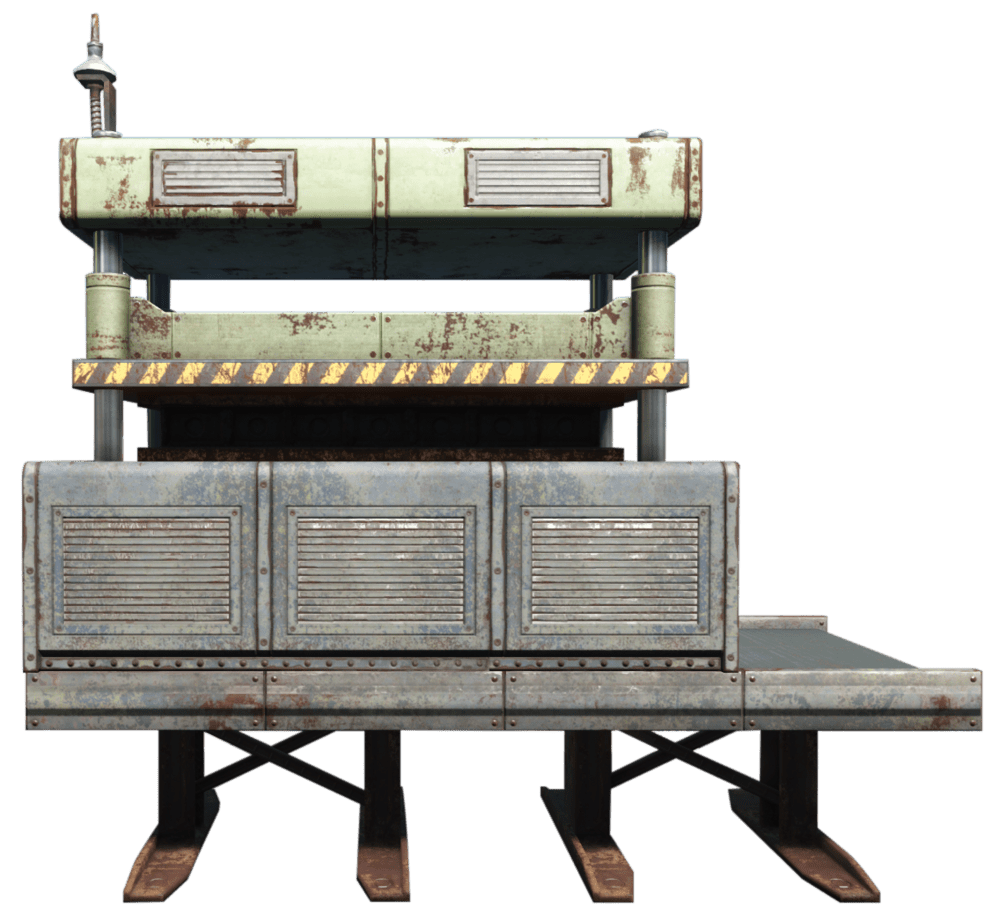
The weapon forge uses crafting components to create one of 10 different firearms.
Nuka-mixer station
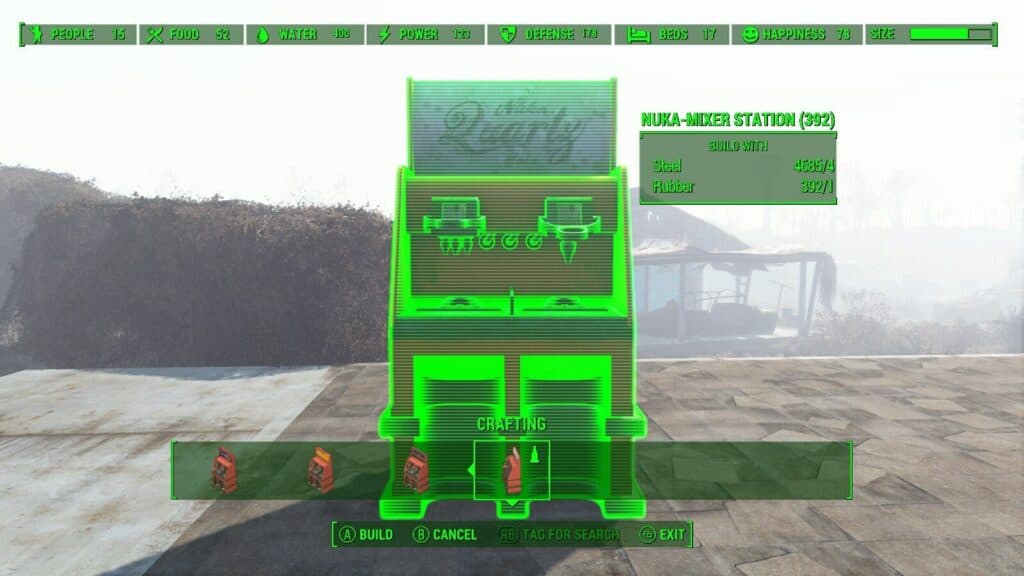
The Nuka-mixer station can create 20 different Nuka-Cola mixes. Nuka-Cola and other beverages like vodka and bourbon are required.
Crafting components
To craft or modify items and objects, you will need to get your hands on crafting components; a whole heap of them. But when you’re out in the Commonwealth, you’ll be picking up junk items. Junk items all have at least one crafting component. The crafting system really turns Fallout on its’ head and makes items that were useless in Fallout 3 extremely valuable. Are you ready to be excited about finding coffee pots or pieces of chalk?
Crafting components come in four rarities: common, uncommon, rare, and zero yields. Zero yields refers to adhesive and oil, as you never receive these when scrapping weapons and armor (More on scrapping later).
Common:
- Bone
- Ceramic
- Cloth
- Concrete
- Leather
- Plastic
- Rubber
- Steel
- Wood
Uncommon:
- Aluminum
- Copper
- Cork
- Fertilizer
- Fiberglass
- Gears
- Glass
- Lead
- Screw
- Silver
- Spring
Rare:
- Acid
- Antiseptic
- Asbestos
- Ballistic fiber
- Circuitry
- Crystal
- Fiber Optics
- Gold
- Nuclear Material
Zero yield
- Adhesive
- Oil
Some crafting components are so plentiful, like steel and wood, that it is borderline impossible to have a shortage of them. But others, like acid, crystal, oil, and adhesive, will be trickier to acquire (Initially).
Shipments of crafting components
While I am aware of the melon farm and purified water baron strategies for making caps, I don’t use them myself. I think it takes a little bit of fun out of the game if I have 100,000 caps at level 3.
If you also don’t use these strategies, what you can expect from Fallout 4 is for money to get considerably easier to make at around level 20. Once you hit level 40, you pretty much won’t have money issues ever again. And this comes in handy when it comes to crafting because of one thing: Shipments.
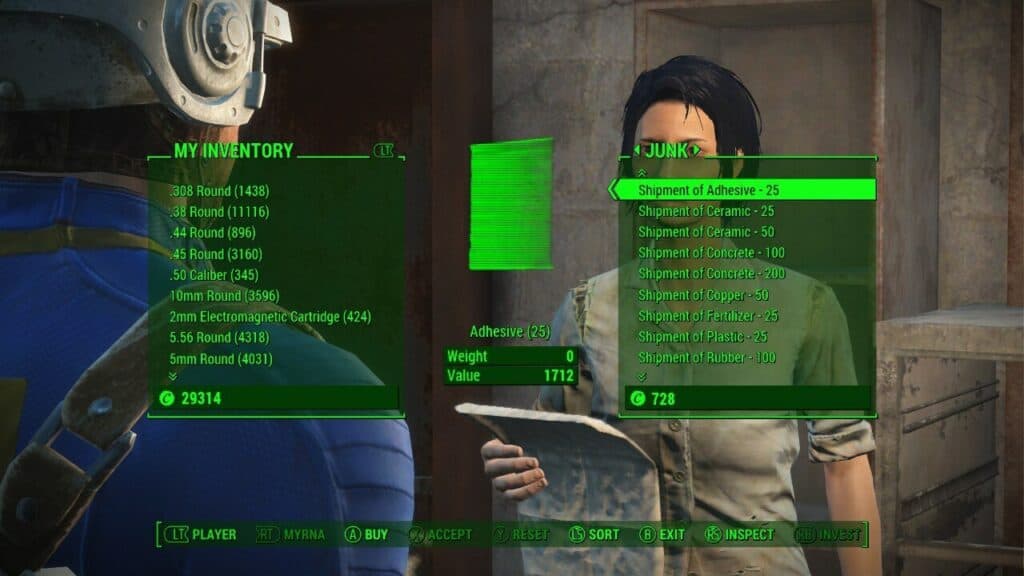
Numerous vendors around the Commonwealth sell shipments of crafting components like crystal, oil, ballistic fiber, gold, silver, etc. It makes getting your hands on a substantial amount of these rarer materials a whole lot easier.
Scrapping
The Scrapper perk is a godsend in Fallout 4, as it makes farming uncommon and rare crafting components significantly easier. It all but eliminates any crafting component shortages.
Scrapper has two ranks in the base game, with a third rank added if you have Far Harbor installed. Scrapper rank 1 requires an Intelligence of 5, and you can choose it immediately. With Scrapper rank 1, you’ll be able to scrap weapons and armor and receive uncommon crafting components like screws, aluminum, and springs.
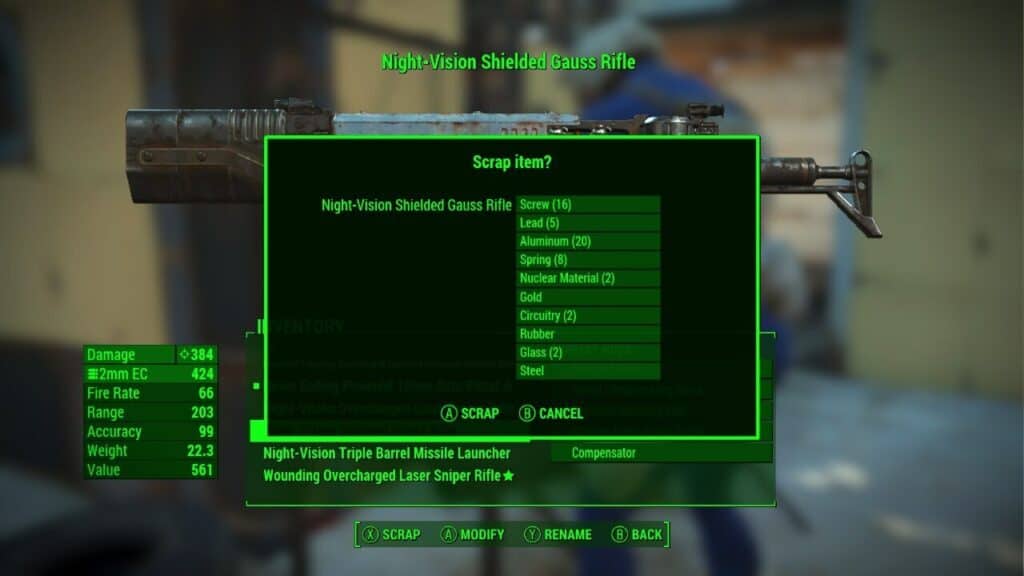
You need to be at least level 23 to select Scrapper rank 2, and once you have it, you can rare crafting components like nuclear material, fiber optics, and ballistic fiber when you scrap weapons and armor.
Scrapper rank 3 requires level 40 and the Far Harbor DLC. With rank 3 of Scrapper, you’ll receive twice the amount of uncommon crafting components that you did before.
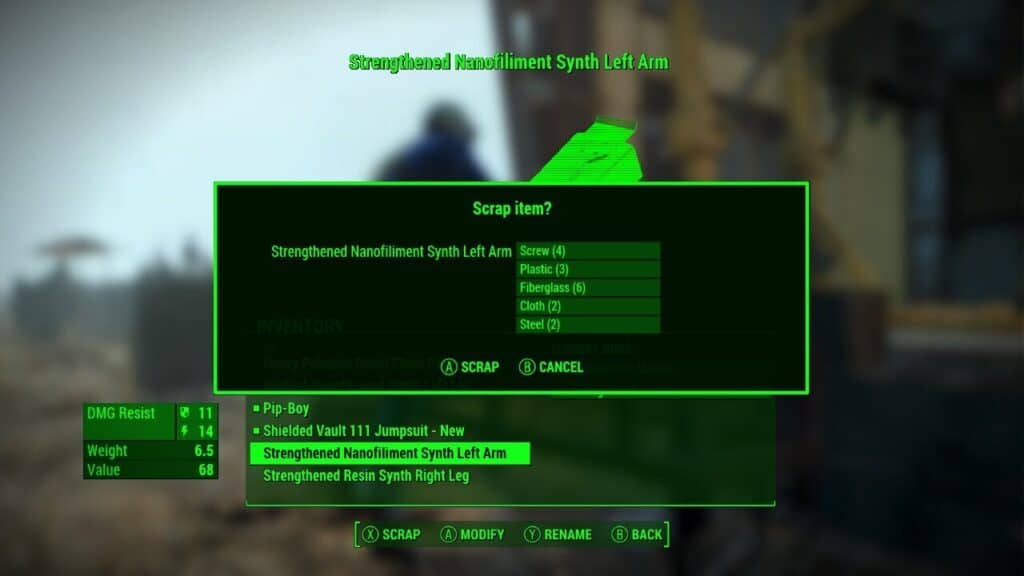
Scrapping is a lot more reliable than buying shipments of crafting components from vendors and is a must-get perk, in my opinion.
Vegetable starch and cutting fluid
Adhesive and oil are arguably the most valuable crafting components in Fallout 4. You need an obscene amount of each, and you can’t get either of them from scrapping.
You can obtain both in shipments from vendors, but the amount of adhesive and oil you can get from them is not nearly enough for your needs. That’s where vegetable starch and cutting fluid come into play. Vegetable starch and cutting fluid are the only reliable ways to get a large amount of adhesive or oil in Fallout 4. You can craft vegetable starch and cutting fluid at the cooking and chemistry stations, respectively.
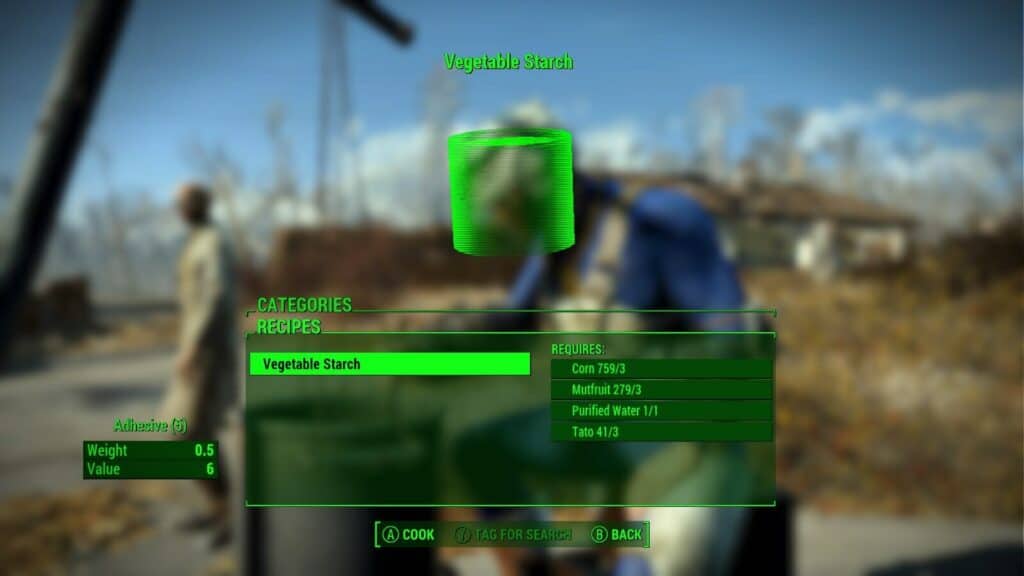
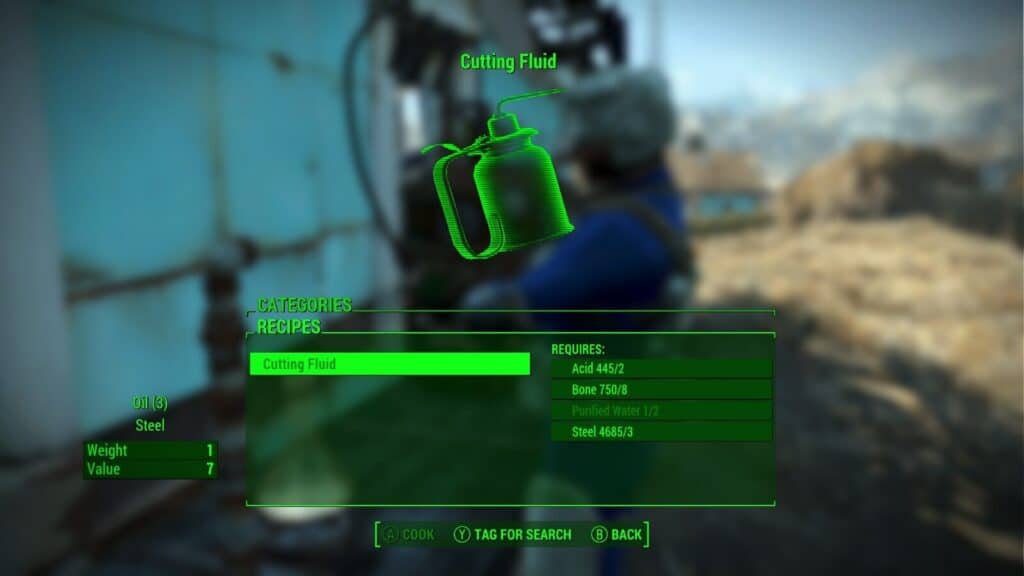
Vegetable starch and cutting fluid require the following components:
Vegetable starch: three tato, three corn, three mutfruit, one purified water
Cutting fluid: two acid, eight bone, two purified water, three steel
Purified Water Farm
You’re going to need a whole heap of purified water when you play Fallout 4, and the only way to get a large amount of it is to make it yourself.
Making purified water is easy; plop a water purifier down into any water source within your settlement’s border. Hook it up to a power source, and you’re good to go.
There are two kinds of water purifiers: Standard and Industrial. I always go for Industrial because it has a much higher production rate than the standard water purifier.
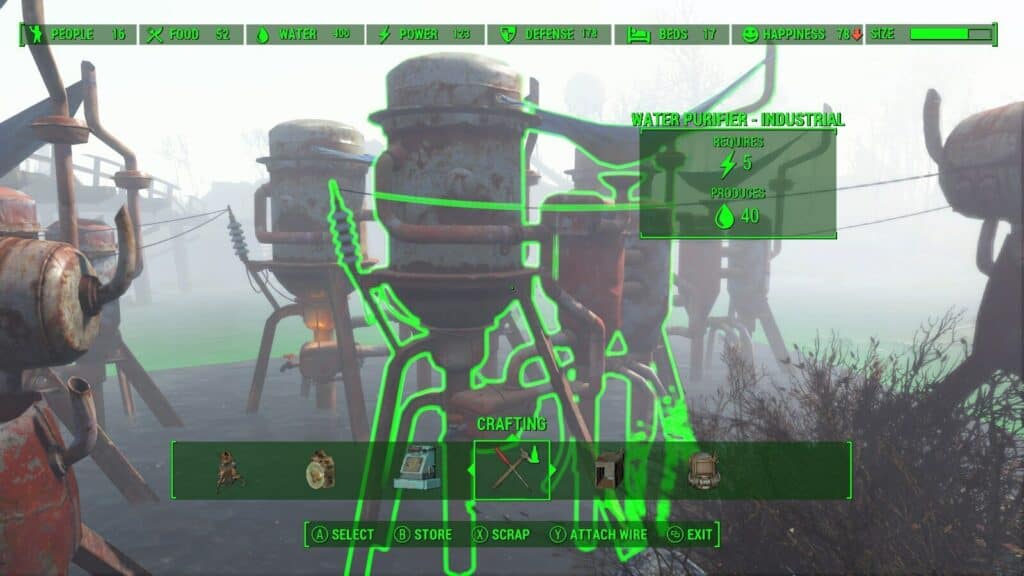
You may run into an issue where your purified water becomes capped. Once you reach this cap, your settlement will cease placing purified water into your workshop. In my game, I never go beyond 299 purified water.
To fix this issue, take the purified water out of your workshop and place them in a different container like a locker or cabinet. I store all my excess purified water at the Red Rocket truck stop.
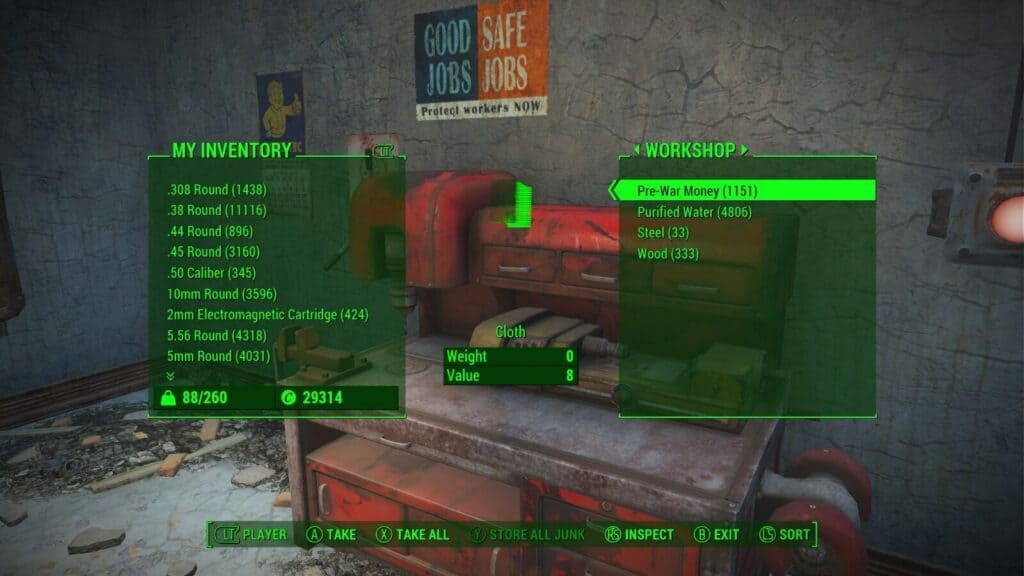
Getting the most out of settlement building
If you want to experience everything this game has to offer regarding settlements, then you’re going to need to invest in a few perks. Most importantly, the Local Leader perk (Which requires 6 Charisma).
Getting the first rank of the Local Leader perk will allow you to establish supply lines between your settlements. After this, you no longer have to drag around components when you want to build things at other locations besides your main base.
The second rank of the Local Leader perk (Which unlocks at level 14) unlocks six stores to build at your settlements. These stores are:
- Trading store
- Armor store
- Weapon store
- First aid station
- Drink & Food store
- Clothing store
Every store has three ranks and starts as simple stands. But by investing in them, they become full-on buildings. Some of these stores require additional perks. Those perks are Cap Collector Rank 2 and Medic Rank 1.
Weapon and Armor Modding: Perks you need
Now I’m sure this part about crafting interests you the most. And why wouldn’t it? Combat is the brunt of this game, after all.
Any player can attach or detach mods without any perk investment. And this comes in handy, as you can get access to mods significantly earlier than if you create the mods yourself. But eventually, you’ll want to get your hands dirty and put the work in yourself. To do that, you’ll need the following perks:
Armorer
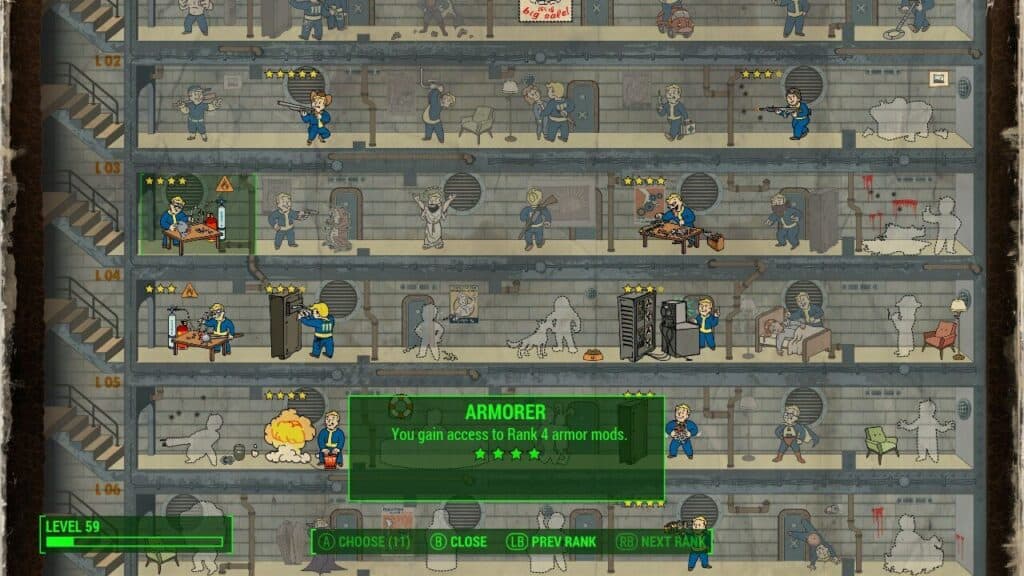
Each rank of the Armorer perk gives you access to the next rank of armor mods.
Blacksmith
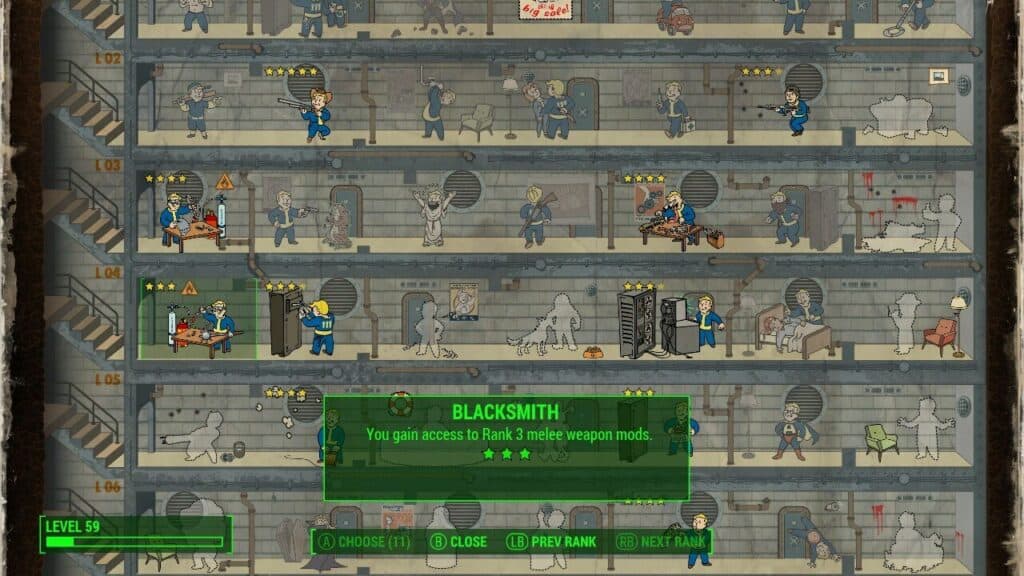
Each rank of the Blacksmith perk gives you access to the next rank of melee weapon mods.
Gun Nut
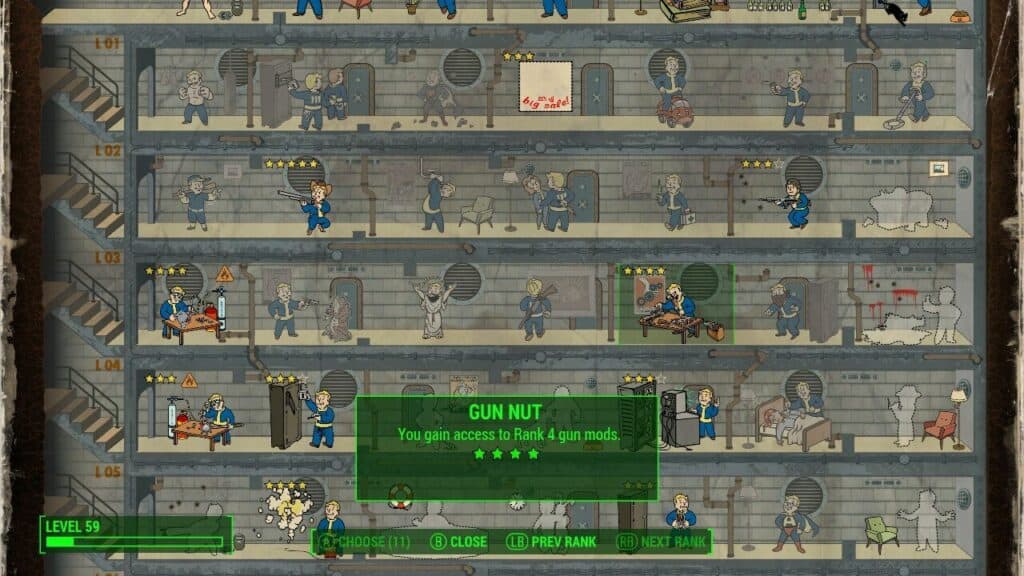
Each rank of the Gun Nut perk gives you access to the next rank of gun mods.
Science!
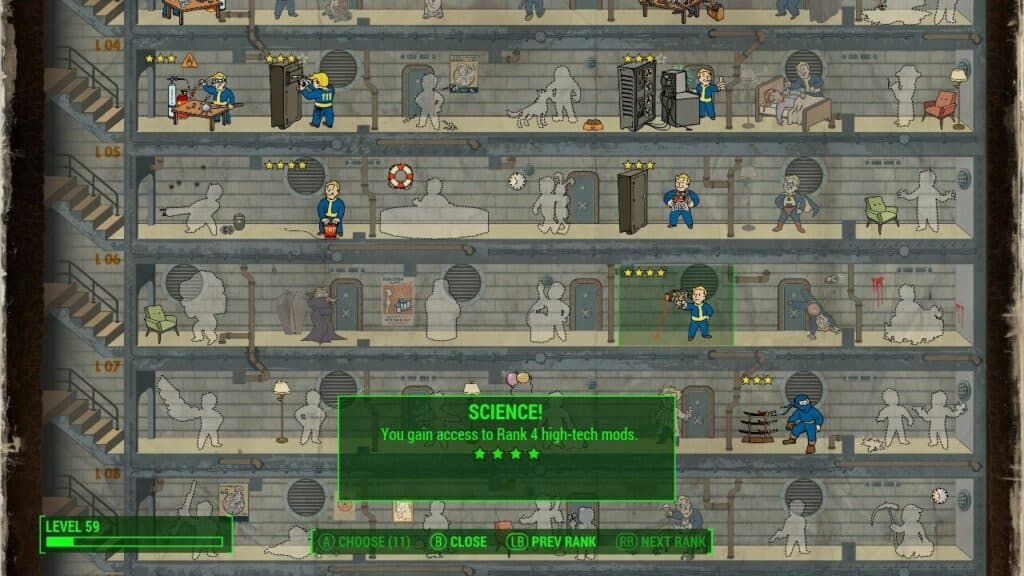
Each rank of the Science! mod gives you access to the next rank of high-tech mods. High-tech mods refer to mods that are energy-based.
These are the main perks you need to invest in to create some weapon and armor mods in Fallout 4. However, these aren’t the only ones.
Some weapons also need investment into weapon proficiency perks to mod. If you want to mod a Western revolver, you need Rank 4 of the Gunslinger perk.
Miscellaneous Tips
Cigarette packs and cartons aren’t just cap fodder anymore!
If you’re coming from Fallout 3, you probably remember how cigarettes had no use in that game except to sell for caps. While this is still the case for loose cigarettes in Fallout 4, you might want to hang on to packs and cartons.
Why? Because cigarette packs and cigarette cartons each contain asbestos. Asbestos is a rare crafting component that can (Among other things) be used in an armor mod to make you immune to fire damage. It took an apocalypse, but cigarettes are finally doing the world some good.
Store your pre-war money OUTSIDE your workshop!
In Fallout 3, selling it for caps was the only use for pre-war money. That’s still the case in Fallout 4, but if you’re not careful, you might burn through your money stash.
Pre-war money is a junk item in Fallout 4, but the only crafting component it contains is cloth. Cloth is an easy-to-find crafting component, so you definitely don’t want to waste your pre-war money like that. But if you keep it in your workshop, that might be what happens.
If you want to avoid this potential problem, keep your pre-war money in a container that isn’t your workshop. It doesn’t matter what kind of container it is, so long as it isn’t your workshop.
Use weapon and armor benches to extend looting trips
Many of the locations you’ll travel to out in the Wasteland will have a weapon bench, an armor bench, or both. If you have the Scrapper perk, you can use these to your advantage.
Break down any weapons or items you have no interest in keeping or selling at one of these benches. Even pipe weaponry can give you valuable components like screws, so don’t disregard anything until you see for yourself what you can get from it.
You can kill two birds with one stone; accrue more components, and spend more time looting the Wasteland per trip.
Bottles are worthless on Normal difficulty but pure gold on Survival Mode
Glass is an uncommon component but not that hard to find. On Normal Difficulty, bottles will quickly become one of the items you ignore when exploring. In Survival Mode, however, bottles are priceless.
You need to drink constantly in Survival Mode to avoid the adverse effects of being thirsty, and any bottle you find is a bottle you can fill up with purified water.
Now I wouldn’t exactly be too keen on taking a bottle out of a mole rat den and drinking out of it, but you do what you have to in a post-apocalypse, I suppose.
Break junk down into raw components to conserve inventory space
Don’t have the Local Leader perk yet, or you do have it and haven’t established supply lines? Hauling components from one settlement to another can be a pain. Some junk items, like bags of cement, weigh a ton and force you to make multiple trips hauling components.
Junk items broken down into their raw components weigh significantly less, so this is a great way to swap components between settlements (Until you establish supply lines).
DON’T break down every junk item!
There are tons of junk items in Fallout 4, and eventually, your junk tab in your workshop is going to be quite cluttered. It’s tempting to break down every junk item you have into raw components to clean things up.
I recommend that you not do that until you 100% know that you don’t need those items. While components are the most important thing, some crafting recipes require specific junk items to create.
Junk items like abraxo cleaner, anti-freeze bottles and bloatfly glands are all needed for some useful recipes. You’re screwed if you break them down into components.
Remember: Specific components aren’t hard to find. Specific junk items? That’s a different story.
Remember crafting component hotspots for easy farming
One of the best things you can do in this game to stay on top of crafting is to keep notes. Run across a place that has a lot of aluminum cans? Make a mental note. Loot respawns, so you can go back to this place later and do it all over.
FAQs
Question: Are there any parts of crafting you would recommend I avoid?
Answer: In all honesty, I find all the Contraptions add-on workshops unnecessary. They’re nifty inclusions, sure, but none add that much value.
Question: Should I pick crafting-related perks as soon as they unlock?
Answer: It’s up to you, but it’s not always necessary or the wisest choice. You might have the perk needed for a new tier of mods but lack the components needed.
Question: Any other suggestions for farming components?
Answer: Always carry around a Charisma outfit with you. You can wear a hat, glasses, and suit that boost your Charisma. In the early game, buying junk from vendors does wonders for obtaining rarer components like crystal or nuclear material. Until you reach level 20/40, every cap counts.
On what Platforms Can I Play Fallout 4?
Answer: Fallout 4 is available on Playstation 4, Xbox One, PC, PSVR
What Other Games Like Fallout 4 Might I Enjoy?
There are a number of titles out there that offer similar RPG elements, Gunplay and other core features within the Fallout series. Which make them great alternatives for those looking for a new adventure. Here is a quick list of options below:
– Fallout New Vegas
– The Outer Worlds
– The Elder Scrolls: Skyrim
– Cyberpunk 2077
– Halo Infinite
Conclusion
Hopefully, after reading this, you know everything you need to in order to have an enjoyable and effective crafting experience in Fallout 4. Once you sink your teeth into it, it can get addicting. Honestly, who knew that collecting base components from desk fans and military grade duct tape could be so rewarding? If you’re anything like me, you’ll find yourself spending hours at the workbench creating the best Mad Max-inspired weapons and armor that you can.
Do you have any favorite crafted items? Let me know in the comment section below!

